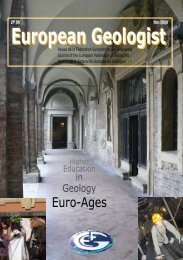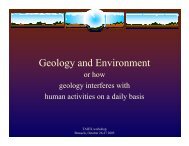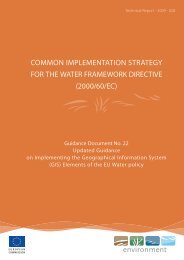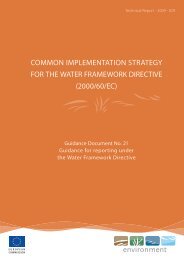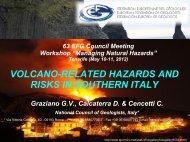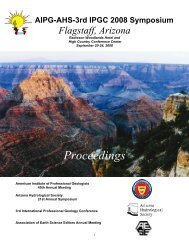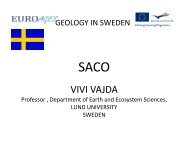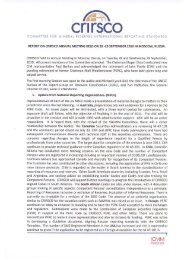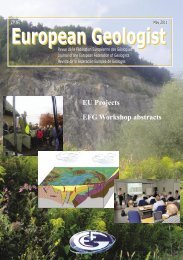European Geologist European Geologist Geoheritage - learning ...
European Geologist European Geologist Geoheritage - learning ...
European Geologist European Geologist Geoheritage - learning ...
You also want an ePaper? Increase the reach of your titles
YUMPU automatically turns print PDFs into web optimized ePapers that Google loves.
Topical - <strong>Geoheritage</strong><br />
and areas, by further designation of<br />
nationally and locally important<br />
sites, and in the wider rural, urban<br />
and marine environments;<br />
4. research to improve our understanding<br />
of the role of geodiversity in providing<br />
benefits to ecosystems and<br />
people, and to address key knowledge<br />
gaps such as the functional links<br />
between geodiversity and biodiversity<br />
in terrestrial, freshwater and<br />
marine environments.<br />
For example, local authorities, public<br />
agencies and government departments<br />
should undertake to ensure that due consideration,<br />
management, enhancement and<br />
promotion of geodiversity and national and<br />
local geosites are an integral part of decision<br />
making. The types of action they can<br />
take include:<br />
• Acknowledging the value and importance<br />
of geodiversity in policy and<br />
guidance documents at national and<br />
local levels, including: national planning<br />
policy and Local Plans; policies<br />
and guidance for biodiversity, nature<br />
conservation, climate change, tourism,<br />
landscape, greenspace, land and<br />
water management, the historic environment<br />
and marine conservation, as<br />
well as seeking advice from appropriate<br />
expert bodies and agencies in<br />
decision making where appropriate;<br />
• Promoting Scotland’s geodiversity<br />
as a tourism asset that adds value to<br />
visitor experience and enjoyment;<br />
• Forming partnerships with local<br />
geoconservation groups to audit<br />
geodiversity sites and develop geodiversity<br />
action plans, and involving<br />
local communities in collating information<br />
about sites of interest (e.g.<br />
former quarries, building stones);<br />
• Encouraging developers to allow<br />
access to temporary exposures to<br />
record and sample, and to contribute<br />
borehole data to BGS.<br />
Appropriate case studies illustrate the<br />
types of action that can be taken. For<br />
example, East Dunbartonshire Council,<br />
one of the signatories, completed a geodiversity<br />
audit in 2010, jointly funded by the<br />
Council and SNH, and carried out by BGS.<br />
In this local authority area in the west of<br />
Scotland, 36 sites were identified for their<br />
geological/scientific merit, education value,<br />
community site value, cultural heritage,<br />
economic importance, access and fragility,<br />
and 34 were recommended as Local Geodiversity<br />
Sites. As well as having geoheritage<br />
importance, the sites have numerous links<br />
to landscape character, historical structures,<br />
ecology and the economic and cultural history<br />
of the area. Such systematic inventory<br />
and evaluation provides a foundation for<br />
developing a Local Geodiversity Action<br />
Plan and better integration of geoheritage<br />
in local planning policies.<br />
As of August 2012, the Charter had<br />
31 signatories, including public bodies,<br />
NGOs, industry and landowner representative<br />
groups, geoconservation groups and<br />
Geoparks; further signatories are expected.<br />
The next step now underway is to monitor<br />
progress towards delivering the aims of the<br />
Charter, to encourage further sign-up and<br />
to develop and promote more examples<br />
of best practice. In terms of outcomes at<br />
a UK level, the Charter also aligns with,<br />
and supports, the UK Geodiversity Action<br />
Plan (UKGAP) (www.ukgap.org.uk) and will<br />
contribute to its delivery.<br />
Opportunities at a <strong>European</strong> level<br />
The type of approach underlying the<br />
Charter may have wider relevance since<br />
conservation of geodiversity and geoheritage<br />
can play a vital part in a more sustainable<br />
Europe in line with a range of EU<br />
policies (Table 1). For example, this was<br />
demonstrated at a stand organized by the<br />
EFG Panel of Experts on Soil Protection<br />
and Geological Heritage, together with five<br />
other <strong>European</strong> Earth Sciences and related<br />
organizations, at the Exhibition, ‘Every<br />
Drop Counts’, held as part of the <strong>European</strong><br />
Commission’s Green Week in Brussels,<br />
22-25 May 2012 (www.eurogeologists.eu). The<br />
key message presented was that the role of<br />
geodiversity in the EU water policy framework<br />
should be enhanced. Care for Europe’s<br />
geodiversity and geoheritage is crucial in<br />
relation to the globally increasing demand<br />
for clean drinking water, management of<br />
water-related hazards such as flooding and<br />
coastal erosion, climate change adaptation,<br />
development of renewable energy (hydro<br />
power) and opportunities for water-based<br />
recreation and outdoor activities with their<br />
benefits for tourism and people’s health and<br />
well-being. Better integration of geodiversity<br />
and geoconservation in existing water<br />
policies, measures and decision frameworks<br />
would help Europe to find more sustainable<br />
solutions that in the long term would<br />
be less costly as well as providing positive<br />
economic benefits. At the same time, it<br />
would help to protect Europe’s geoheritage<br />
and safeguard the quality of the living<br />
environment of <strong>European</strong> citizens, while<br />
mitigating risks such flooding, biodiversity<br />
loss and soil loss.<br />
Conclusion<br />
Integration of geodiversity in wider<br />
environmental policy and decision frameworks<br />
is now essential not only to protect<br />
our geoheritage, but also to ensure more<br />
holistic conservation management of biodiversity,<br />
geodiversity and landscape through<br />
an ecosystem approach, to inform climate<br />
change adaptations, and to contribute to<br />
resolving broader environmental, economic<br />
and social issues. Scotland’s Geodiversity<br />
Charter represents an important step in this<br />
direction. It instigates a process through<br />
which key stakeholders will work together<br />
to achieve greater awareness of geodiversity<br />
and the realization of its benefits through<br />
the sustainable management of land and<br />
water, consistent with the economic, social,<br />
cultural and environmental needs of Scotland.<br />
By moving in this direction, the Charter<br />
aims to demonstrate that geodiversity<br />
matters and that geoscience knowledge<br />
and geoconservation can deliver positive<br />
benefits for people and the environment<br />
at national and local scales. In doing so, it<br />
should help to place geoconservation and<br />
geoheritage on a more strategic footing.<br />
This is part of a broader <strong>European</strong> challenge<br />
to raise awareness of the value and<br />
benefits of geodiversity at a policy level and<br />
to position geodiversity at the foundation<br />
of an ecosystem approach.<br />
Acknowledgements<br />
We thank Eleanor Brown, Natural England,<br />
for helpful comments. HFB publishes<br />
with permission of the Executive Director<br />
of the British Geological Survey.<br />
<strong>European</strong> <strong>Geologist</strong> 34 | November 2012<br />
51



